gruen
Harmless

Posts: 3
Registered: 13-5-2018
Member Is Offline
|
|
Have i created dichromates ...
I wanted to create sulfuric acid from epsom salt. (the idea was a bit to use widely available things not that i couldnt obtain the acid directly)
I used a detergent bottle cut open on the side so its handle connected the upper and lower part. Placed on its handle that forms 2 connected
containers. i then cut a piece of PP fabric (shopping bag) up and stuffed it in the handle. That forms our membrane for electrolysis.
Filled the "bottle" with water and 20g of epsom salt (whatever hydrate that was).
Then used a graphite anode and magnesium cathode (the cathode material probably is irrelevant) electrolysis was done for 1-2 days at 400mA and voltage
in the 50-90V range. The handle gets quite hot and the whole needed to be placed into a container with standing water for cooling.
At the cathode a white solid forms, which should be Mg(OH)2. After drying that was 2.7g.
(in fact this was my 3rd attempt at this, my first only got 0.6g and 2nd failed totally, the first used hot glue in a glass to hold the membrane, the
2nd had a long tube filled with PP fabric between 2 glasses)
The liquid at the anode was dirty from graphite and impurities from the "pure" graphite electrode from china. The liquid was quite acidic and produced
expected CO2 with Na2CO3.
Now i still had a "platinized titanium" electrode from china as well. I was quite aware that it was fake and got already refunded by the seller but
due to curiosity i thought id try it anyway.
The material of the electrode was slightly magnetic and had a density around 8(+.0.5)g/cm3 i guess it is Austenitic stainless steel. I only wanted to
try it until i see visible loss of material but then didnt look for several hours. And when i looked it was thinner at the part that was submerged. I
belive it lost about 2g of material or so. The electrolyte was orange on the anode side and the cathode was covered in solid brown gunk, i presume
iron hydroxide or some other iron compound with more Mg(OH)2 mixed in.
I then spend some time trying to find out if such setup would create (di)chromates and how to change them into something less toxic.
Testing a small amount of the orange electrolyte by adding vodka results in a smell very different from ethanol and acetic acid. I assume that is
Acetaldehyde. At this point the color was still orange, several hours later it changed to pale green. The original orange electrolyte when mixed with
Na2CO3 also forms a brown precipitate at about pH 3 i presume that is some iron compound. The remaining liquid is orange when acidic and yellow when
basic. Which matches how (di)chromates would behave ...
Trying to boil down a small sample of the liquid (in a semi proper distillation setup to avoid any acid vapors going into the air) results in a tiny
amount of clear and colorless viscous liquid with tiny amount of black precipitate remaining. Cooling it showed no noticeable additional precipitate.
The viscous liquid was quite acidic. All the distilled off liquid was clear, colorless and almost pH neutral, i think one drop of acid spilled over or
so. IIRC The plate temperature was 250°C. I made no attempt to distill the acid itself over.
The amount of (di)chromate in the orange liquid must be quite small but still iam quite surprised how easy it was to create this. Especially
considering my knowledge and experience is at a basic level only.
Not sure anything in here is new or its all well known, but maybe its useful to someone
|
|
|
ninhydric1
Hazard to Others
  
Posts: 345
Registered: 21-4-2017
Location: Western US
Member Is Offline
Mood: Bleached
|
|
It is not necessarily dichromate; it could also be Fe3+ present in solution.
The philosophy of one century is the common sense of the next.
|
|
|
woelen
Super Administrator
        
Posts: 7976
Registered: 20-8-2005
Location: Netherlands
Member Is Offline
Mood: interested
|
|
Add a few drops of H2O2 to the orange solution. If it contains dichromate, then you get a deep blue solution.
|
|
|
Texium
|
Thread Moved
14-5-2018 at 07:57 |
gruen
Harmless

Posts: 3
Registered: 13-5-2018
Member Is Offline
|
|
Would Fe3+ not have been removed as hydroxide in the sample that i added Na2CO3 to ?
What i did exactly IIRC was add Na2CO3 drop wise until precipitate started to form (that was at pH3) then added more and filtered the precipitate off.
what remained was on the basic side and yellow and clear, adding citric acid made it orange again.
H2O2 is a really good idea, i will try to obtain some
In the meantime as the question, what it is kept nagging me, even though i actually have no time  . i searched for something else i can do with the limited set of reagents i have. I found some old silver/potassium
nitrate sticks. . i searched for something else i can do with the limited set of reagents i have. I found some old silver/potassium
nitrate sticks.
I took 5ml of the orange solution (see attached image 1) and added Mg(OH)2 (which i made earlier from MgSO4) with stirring. First nothing happened
then precipitation starts to form i kept adding until formation of more precipitation clearly stopped. (see attached image 2) I then waited a bit and
then filtered. The solution is yellow (see attached image 3). Its pH is around 8
I added a (few?) drop(s) of silver/potassium nitrate solution. It immediately turns dark red (see attachment 4). Adding more deepened the color. A bit
stirring and waiting and filtering shows red solid and crystal clear liquid (see attachment 5). After washing the filter a few times with distilled
water and drying at 85°C there was 13mg of red solid.
I also tried adding the silver/potassium nitrate solution to the original orange solution, this showed no effect. adding a stick directly into the
orange solution though shows also some red precipitation forming around it (see last attachment)
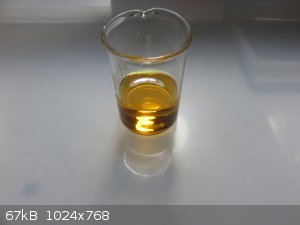 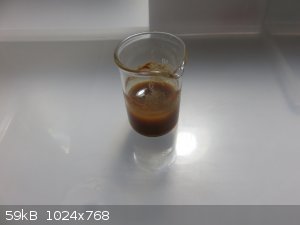 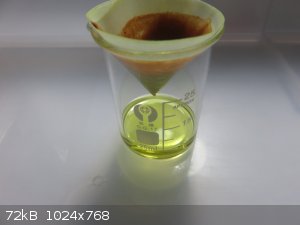 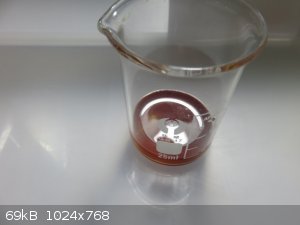 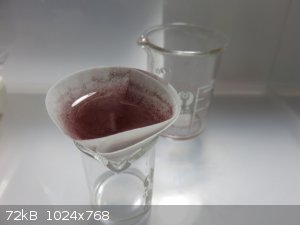 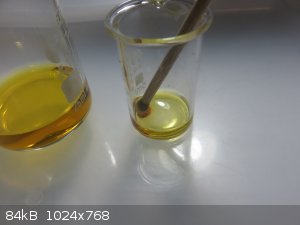
|
|
|
woelen
Super Administrator
        
Posts: 7976
Registered: 20-8-2005
Location: Netherlands
Member Is Offline
Mood: interested
|
|
Based on your data, I have the impression that your solution contains a small amount of dichromate, but only a really small amount.
Silver nitrate gives a deep red precipitate with dichromate ions of silver dichromate in strongly acidic solution and a red/brown precipitate of
silver chromate in weakly acidic or neutral solution.
A much more sensitive test is the test with H2O2. You'd best make a very dilute acidic solution of appr. 0.1% H2O2 + a few 0.1%'s of HCl (or H2SO4)
and to this add a few drops of your test solution. Even if the test solution only contains 0.01% or so of dichromate, then you get a clearly visible
beautiful blue color of a peroxo complex, CrO(O2)2.
|
|
|
Sulaiman
International Hazard
    
Posts: 3558
Registered: 8-2-2015
Location: 3rd rock from the sun
Member Is Offline
|
|
Last night I read woelen's post, which stimulated me to go to the shed:
In a 10ml beaker c10mg of ammonium dichromate dissolved in 3ml H2O gave a clear orange solution.
A few drops of 10% H2O2 produced a dark black/blue/brown colour, no deep blue as described ...?
so guessing a concentration problem I dumped the solution into 100ml H2O which became dichromate yellow/orange ?
pH ? ... adding conc. H2SO4 changed the top 3/4 of the solution deep blue ! ... success.
(quick test, no stirring)
Amazingly dense deep blue from so little dichromate... a very sensitive test/indicator.
Later the solution turned light blue-green.
P.S. this is the first time I've thought of hydrogen peroxide as a reducing agent.
P.P.S. it seems that sometimes there is a lot more to see without stirring than with,
e.g. a gradient of oxidation states can be seen between areas of different concentrations of reactants.
P.P.P.S. (!) or you can do it the pretty way around, maintaining excess peroxide;
https://www.youtube.com/watch?v=59nKbHbdQ-A
[Edited on 15-5-2018 by Sulaiman]
CAUTION : Hobby Chemist, not Professional or even Amateur
|
|
|
woelen
Super Administrator
        
Posts: 7976
Registered: 20-8-2005
Location: Netherlands
Member Is Offline
Mood: interested
|
|
To make the test even more sensitive is to take 10 ml or so of your liquid to be tested, to this add a small amount of H2O2 and acid (only very small
amounts should be used) and then add 1 to 2 ml of diethyl ether and shake well for a while. The ether and aqueous layers will separate again when you
stop shaking. This causes the blue compound to be extracted into the ether layer, it dissolves better in ether than in water. In the ether layer it is
much more stable than in the water layer and because of the smaller volume of ether you make its concentration larger.
You can even further stabilize the blue compound when you add pyridine to the solution. The compound then reacts with the pyridine, giving a bright
blue/indigo compound, which separates from the solution as a solid. It is nice to try that one if you have pyridine. With that you can use higher
concentrations and you can isolate the blue pyridine/CrO5 complex. i would not store the complex for a long time though, even the pyridine complex is
not 100% stable and it slowly decomposes, giving oxygen and hence pressurizing the container in which it is stored if this is sealed.
|
|
|
gruen
Harmless

Posts: 3
Registered: 13-5-2018
Member Is Offline
|
|
Took me a bit long, but i finally found the time to test with H2O2. I used some 0.3% H2O2 (diluted from 3%, contains some NaCl impurity but that was
easy to obtain).
Adding drops of that produces beautiful blue "clouds".
A video showing it should be here:
https://rumble.com/v5md3f-testing-for-dichromate-with-h2o2.h...
I have no pyridine nor ether. And it seemed to work fine without acidifying the H2O2, the orange solution is already quite acidic.
|
|
|